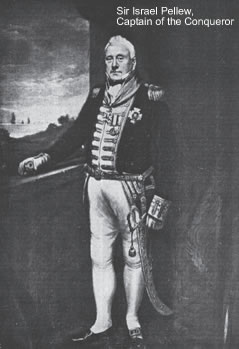Israel Pellew facts for kids
Quick facts for kids
Sir
Israel Pellew
|
|
|---|---|
 |
|
| Born | 25 August 1758 Dover, England |
| Died | 19 July 1832 (aged 73) Plymouth, England |
| Allegiance | United Kingdom |
| Service/ |
Royal Navy |
| Years of service | 1771–1830 |
| Rank | Admiral |
| Commands held | HMS Resolution HMS Squirrel HMS Amphion HMS Greyhound HMS Cleopatra HMS Conqueror |
| Battles/wars | |
| Spouse(s) | Mary Helen Gilmore |
| Relations | Edward Pellew, 1st Viscount Exmouth (brother) |
Admiral Sir Israel Pellew (born August 25, 1758 – died July 19, 1832) was a brave and skilled English naval officer. He served in the Royal Navy for many years. His older brother, Edward Pellew, was also a famous admiral. Israel Pellew often served alongside or near his brother.
Israel Pellew began his life at sea in 1771. He was just 13 years old when he joined the sloop Falcon. He served in the West Indies and later in North America. By April 1779, he became a lieutenant. He then served on several frigates.
In 1782, Pellew took command of the cutter Resolution. He sailed in the North Sea. A year later, he captured a Dutch privateer ship called Flushinger. This was a single-ship battle, meaning just two ships fought. Pellew stayed in command of Resolution until 1787. He was promoted to commander in 1790.
When the French Revolutionary Wars began in 1793, Pellew did not have a ship. So, he volunteered to serve on his brother Edward's ship, Nymphe. During a battle on June 18, 1793, Nymphe captured the French frigate Cléopâtre. This was the first British naval victory of the war! For his bravery, Israel Pellew was introduced to King George III. He was then made a post captain and given command of Squirrel.
In 1795, Pellew became captain of a larger frigate, Amphion. He commanded her near Newfoundland and in the North Sea. In September 1796, a terrible accident happened. While Amphion was in Plymouth for repairs, she suddenly exploded! About 300 people, including crew and visitors, died. Amazingly, Pellew survived. He was blown through a window and landed on another ship's deck. An investigation suggested the ship's gunner caused the explosion. However, Pellew had already warned that the ship's gunpowder storage was unsafe.
In 1797, Pellew was given command of Greyhound. But her crew later joined a mutiny (a rebellion by sailors). Under pressure, Pellew left the ship. In July, he took command of Cleopatra. He commanded her in the English Channel and later in Halifax and Jamaica.
In 1800, Pellew faced some challenges. An attack by his boats to capture Spanish ships off Cuba failed. His ship, Cleopatra, also ran aground (got stuck) off the Abaco in the Bahamas. She was stuck for three days. They had to throw guns and heavy items overboard to get her free.
The Trafalgar Campaign
Pellew returned to sea in April 1804. He commanded the large warship Conqueror. His ship sailed in the English Channel and then to the Mediterranean. They chased the French fleet across the Atlantic Ocean. During this time, Pellew became good friends with his admiral, Lord Nelson. He joined Nelson's famous group of trusted officers, known as the Band of Brothers.
The Conqueror fought bravely at the famous Battle of Trafalgar in 1805. She was the fourth ship in Nelson's column. The French admiral Villeneuve's flagship, the Bucentaure, surrendered to Conqueror. Pellew sent his Royal Marines captain to receive Villeneuve's sword. But Conqueror had to keep fighting other enemy ships. So the Marines could not return the sword to Pellew right away. During the battle, Pellew was hurt by a cannonball that landed very close. But he refused to report his injury until after the fighting was over.
After the battle, the French admiral's sword was given to Admiral Collingwood. This made Pellew quite upset. He was also a bit annoyed because of his famous brother. When the Marines boarded the Bucentaure, Admiral Villeneuve asked who had captured him. When told it was Captain Pellew, Villeneuve thought it was the famous Sir Edward Pellew. He said he was glad to surrender to such a lucky officer. The Marine captain had to correct him, saying it was Edward's brother. Villeneuve then exclaimed, "His brother? What, there are two of them? Oh no!"
Even though Conqueror's sails and ropes were badly damaged, only three of her crew died and nine were wounded. This was amazing, considering how intense the battle was. She returned to Gibraltar safely after the battle. After Trafalgar, Conqueror helped blockade Cádiz. In 1807, she helped secure the Portuguese fleet and royal family. Pellew then left the ship.
Admiral and Retirement
In 1810, Israel Pellew was promoted to rear-admiral. In 1815, he was knighted. In 1816, his brother Edward became commander of the Mediterranean fleet. He made Israel his captain of the fleet, which meant Israel was his chief of staff. Israel Pellew played an important role in talks with the Barbary powers. He also took part in the bombardment of Algiers that year. This was his last active service at sea.
Pellew continued to be promoted. He became a vice-admiral in 1819. Sadly, in the same year, his only son, Edward, tragically lost his life in a confrontation in Paris. Israel Pellew was promoted to a full admiral in 1830. He retired to Plymouth and passed away there in 1832 after a long illness.
Pellew was buried in Charles the Martyr Church in Plymouth. However, during the Blitz in World War II, a massive German air raid in 1941 destroyed the church and its graveyard. The church ruins remain as a memorial. But there is no longer any sign of where Pellew's body or tomb was located.

